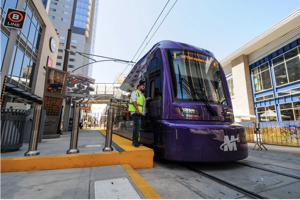UPDATE: Tyler, Texas, is urgently exploring a new light rail system as the city grapples with escalating traffic congestion. With a population nearing 250,000 and approximately 2,000 people migrating to the area each year, city officials are keen to find sustainable transportation solutions.
Michael Howell, director of Tyler’s Metropolitan Planning Organization, stresses the growing need for public transit options. “How can you go somewhere and not have it be just you getting into a car?” Howell posed, highlighting the finite space available for parking as the region continues to expand.
This potential shift toward light rail marks a significant change for Texas, a state historically dominated by car culture. Recent discussions among state lawmakers even suggested defunding existing light rail systems in major cities like Dallas and Houston, raising concerns about public transit accessibility.
Tyler’s rapid growth, fueled largely by its thriving healthcare sector, has led to increased traffic woes, particularly around the medical district that houses two hospitals and a medical school. Howell noted that navigating this area has become increasingly challenging, with parking shortages expected to worsen as the city invests over $25 million in downtown improvements.
“More congestion means, frankly, wasted time for residents,” said Yonah Freemark, a researcher at the Urban Institute. “It ultimately impacts people’s quality of life.”
Tyler’s efforts to implement a light rail system come amidst broader discussions about effective public transit solutions. Cities like Seattle have successfully managed growth without a corresponding rise in car ownership, showcasing the potential benefits of robust public transport.
However, experts warn that light rail systems require substantial population bases and financial backing from both state and federal authorities. Howell is optimistic about leveraging existing freight and abandoned lines in Tyler, which could ease the financial burden of establishing a new rail system.
Additionally, a coalition is advocating for a passenger rail line connecting Dallas to Atlanta, which could present opportunities for Tyler to integrate into a larger network. However, this would necessitate cooperation from Union Pacific, the owner of many lines in the region.
“Planning ahead is smart,” noted Mena I. Souliman, a professor at the University of Texas at Tyler. “A thorough cost-benefit study would be key steps to see if it is realistic here.”
In an effort to gauge community interest, Tyler has commissioned a $150,000 study from Kimley-Horn and is actively seeking public input. An online survey has already garnered responses from over 100 residents, with a virtual town hall scheduled for September 23 to further engage the community.
Howell emphasized the importance of community feedback, stating, “This is really us trying to prime the community to ask the right questions.” If residents express strong support for the light rail system, city planners can move forward with detailed proposals. Conversely, if the response is lukewarm, Howell is prepared to explore alternative congestion solutions.
As Tyler navigates its growth, the outcome of this survey could significantly shape the future of transportation in the city. Residents and stakeholders alike are urged to voice their opinions, as the decision on public transport could impact the quality of life for years to come.






